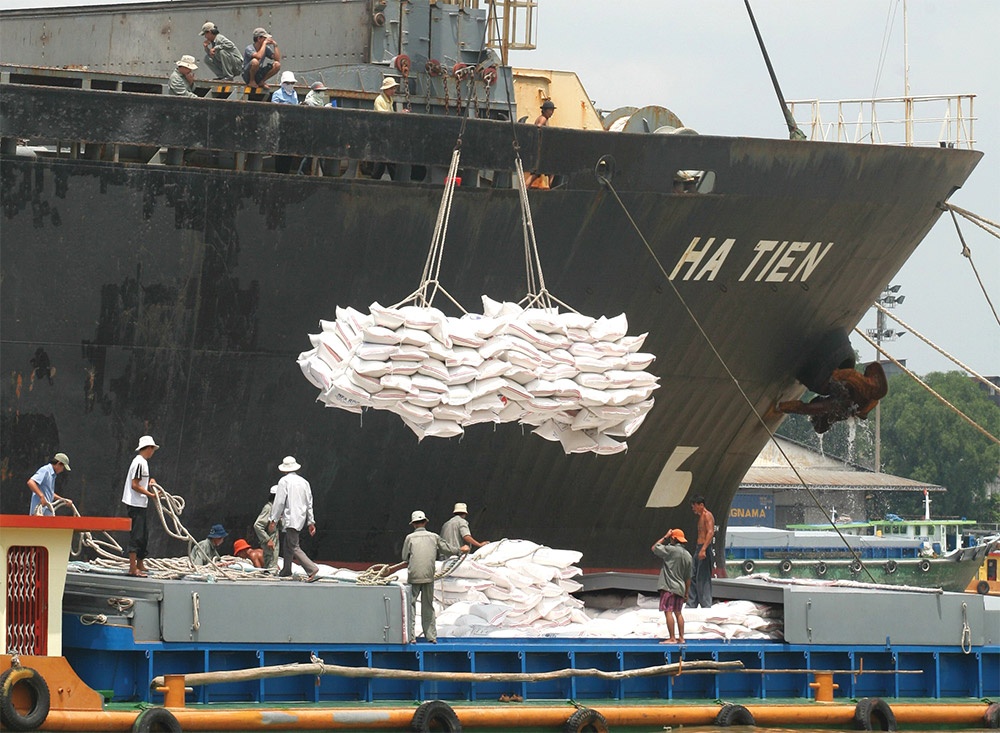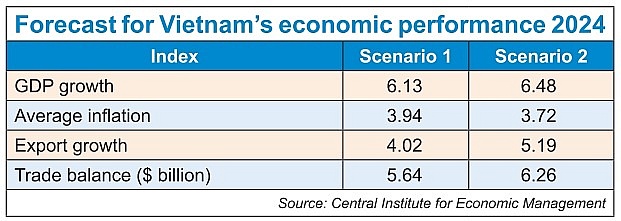Positive vibe covers growth prospects
 |
| Exports will serve as one of the key drivers of economic growth in 2024, Le Toan |
The Central Institute for Economic Management (CIEM) over a week ago released two economic growth scenarios, expecting that the Vietnamese economy may perform more remarkable than last year, with better indexes (see box).
 |
The CIEM has underlined the key groundwork for such forecasts.
“In 2023, Vietnam drastically implemented many effective solutions in socioeconomic development based on closely monitoring over the domestic and international situations, and then devising and applying proper policy adjustment – for example in some sectors including taxes, credits, and property,” stated a CIEM report which covers the scenarios.
One such solution was the National Assembly’s (NA) decision to extend a VAT reduction to 8 per cent for the third time, which was confirmed at the end of last year.
The VAT decrease is offered to assorted goods and services, with the exception of telecommunications, financial activities, securities and insurance, trading of real estate, metal and mining products (except coal), other chemicals, services subject to excise tax, and more.
“This initiative is aimed to stimulate consumption demands in line with the existing economic situation, contributing to spurring on business and production activities to soon recover and in return, they will make contributions to the state coffers and the economy,” read a governmental proposal sent to the NA.
In 2023, the total value of all policies used for supporting the public and enterprises mounted to be about $8.37 billion, including $6.96 billion worth of tax-related assistance.
For 2024, Prime Minister Chinh stated, “New measures will be used to assist enterprises and the public. We will also ask the NA to allow us to continue implementing policies on exempting and reducing taxes and fees, while timely enacting appropriate and effective policies related to the global minimum tax.”
According to the CIEM, the government has also made big breakthroughs in institutional reform, especially about improving policy frameworks for digital economy and circular economy, and regional connectivity, while having also boosted economic diplomacy to expand export markets and look for new resources for national development.
“Thanks to this, Vietnam has effectively dealt with negative impacts from the world market to ensure its macroeconomic stability and major balances, continuing to maintain and strengthen the confidence of both domestic and international investors,” said CIEM general director Tran Thi Hong Minh.
Vietnam’s real GDP has surpassed the economy’s potential in Q3 and Q4 of 2023, Minh said. After growing 3.32 per cent on-year in Q1 2023, the Vietnamese economy bounced back to 4.14 per cent on-year in Q2, 5.33 per cent on-year in Q3, and 6.72 per cent in Q4. The rate for the whole year was 5.05 per cent.
“Such a growth from quarter to quarter has reflected positive impacts of demand-stimulating solutions in the second half of the year,” the CIEM report read.
Many other international organisations remain upbeat about Vietnam’s growth outlook this year, buoyed up by an uptrend in production and exports, as well as investor confidence.
Tradingeconmics last week forecasted that the GDP in Vietnam is expected to be 5.10 per cent by the end of this quarter. In the long term, the rate may trend around 6.10 per cent in 2024 and 5.90 per cent in 2025.
Over two weeks ago, Standard Chartered Bank released its fresh projection that Vietnam will enjoy robust GDP growth of 6.7 per cent in 2024 (6.2 per cent in H1 and 6.9 per cent in H2).
“Vietnam continues to offer a promising medium-term outlook.” said Tim Leelahaphan, economist for Thailand and Vietnam of Standard Chartered. “To maintain rapid growth and competitiveness, Vietnam needs to upgrade infrastructure and prepare to lower carbon emissions.”
According to Leelahaphan, retail sales and industrial production have stayed robust despite the recent moderation. Exports and imports are starting to recover, though electronics-related trade remains tentative.
Last month, credit rating agency Fitch Ratings released its projection that Vietnam’s growth rate in the medium term may reach about 7 per cent, with many favourable signs.
“We have increasing confidence that near-term economic headwinds from property-sector stresses, weak external demand and delays in policy implementation owing to a corruption crackdown are unlikely to affect medium-term macroeconomic prospects and that policy buffers are sufficient to manage near-term risks,” Fitch Ratings said.
Under Fitch Ratings’ assessment, Vietnam’s foreign-exchange reserves improved modestly, to $89 billion as of end-September 2023, after a sharp drop in 2022. This partly reflects some return of capital flows and a larger trade surplus.
“We expect reserves to improve further in 2024-2025 with coverage of current external payments averaging about three months, under our baseline. Vietnam’s external debt composition remains favourable, as most of the debt is owed to bilateral and multilaterals,” the agency said. “This leads to a lower external debt service burden and supports its high external liquidity ratio.”
Many other organisations have set a positive economic growth target for Vietnam, including the International Monetary Fund (5.8 per cent), the World Bank (5.5 per cent), the Asian Development Bank (5.2 per cent), and Moody’s (5.6 per cent).
 | New roads the answer for economic growth It is projected that 2024 could be a bumper year for expressway construction to get moving, with several localities approving plans for vital connection infrastructure. |
What the stars mean:
★ Poor ★ ★ Promising ★★★ Good ★★★★ Very good ★★★★★ Exceptional
Related Contents
Latest News
More News
- Main drivers for Vietnam’s digital economy future (December 03, 2025 | 11:35)
- Pivotal stage of growth paves way for rise in M&As (December 03, 2025 | 10:00)
- Positive projections for M&A interest from Thailand (December 03, 2025 | 09:40)
- Manifesting the first line of defence in cybersecurity (December 03, 2025 | 09:00)
- The transformational role AI can play in accounting arena (December 03, 2025 | 08:00)
- Unlocking 5G-AI potential in Singapore (December 03, 2025 | 08:00)
- Data-driven strategies vital for a fast-evolving nation (December 02, 2025 | 09:41)
- Policy to practice: how Vietnam can lead the region (November 26, 2025 | 16:03)
- Mobilising private capital at scale vital for climate battle (November 26, 2025 | 15:36)
- VILAF and Yoon & Yang launch Vietnam - Korea Practice Unit (November 26, 2025 | 15:16)

 Tag:
Tag:




















 Mobile Version
Mobile Version